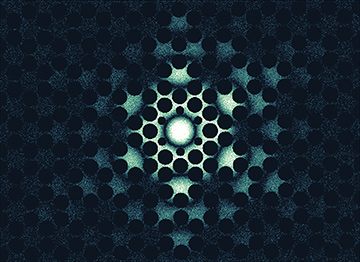 Optically measured displacement pattern of the localized vibrational mode studied in the works described here. A hexagonal lattice of holes confines the mode, while dramatically reducing its energy dissipation. [Enlarge figure]
Optically measured displacement pattern of the localized vibrational mode studied in the works described here. A hexagonal lattice of holes confines the mode, while dramatically reducing its energy dissipation. [Enlarge figure]
Optical interferometry is a powerful tool for precision displacement measurement, enabling science from scanning probe microscopy to gravitational-wave detection. With such pursuits in mind, the quantum-mechanical limit of an interferometer was laid out some 50 years ago,1 establishing a sensitivity bound that limits the Laser Interferometer Gravitational-Wave Observatory (LIGO) even today. Schemes to overcome this standard quantum limit (SQL) have been proposed and fruitfully tested over the years, but the limit itself remained unbroken. In a series of recent works, we have demonstrated optical interferometric measurements of a macroscopic object with a sensitivity at and beyond this quantum limit.2–4
The SQL reflects a tradeoff between quantum noise sources in an interferometric displacement measurement. A stronger beam yields better sensitivity, but at the cost of adding momentum kicks due to randomly arriving photons. These kicks perturb the object’s position, adding “quantum backaction.” The SQL reflects an optimal balancing of these terms, and reaching it requires a strong measurement and very efficient light collection.
We access this regime by applying the toolbox of quantum optics to probe a vibrating membrane with exceptionally good mechanical properties. By engineering a defect in a 2-D phononic crystal (patterned in a 3 mm × 3 mm × 20 nm Si3N4 membrane), we produce a resonant mode with a mechanical quality factor of 109 at a frequency of 1 MHz.
With this central ingredient, and using a standard interferometric measurement, we were able to measure the membrane’s motion with a sensitivity within 35% of the SQL.2 With such a precise measurement record, we could apply a feedback force and actually cool the mode to its vibrational ground state, a first-of-its-kind achievement.2 In a separate work,4 we showed how this precise measurement actually effects strong (projective) measurements of the motion, purifying the state by measurement and tracing out the resonator’s quantum trajectory.4
Going beyond standard interferometry, we implemented a “variational” readout scheme, using quantum correlations generated by the strong optomechanical interaction. In this work,3 we demonstrated, for the first time, a displacement measurement with a sensitivity 1.5 dB below the SQL. We believe that these studies mark a milestone in optical displacement measurement and set the stage for both fundamental quantum science and state-of-the-art sensing applications.
Researchers
David Mason, Massimiliano Rossi, Junxin Chen and Albert Schliesser, Niels Bohr Institute, University of Copenhagen, Copenhagen, Denmark
References
1. C.M. Caves. Phys. Rev. D 23, 1693 (1981).
2. M. Rossi et al. Nature 563, 53 (2018).
3. D. Mason et al. Nat. Phys. 15, 745 (2019)
4. M. Rossi et al. Phys. Rev. Lett. 123, 163601 (2019).

